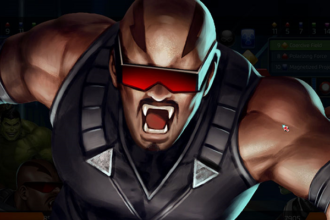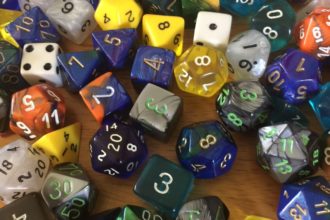The Ranger Class, Part Seven

This time in History of the Classes, we’re wandering some distance afield of Dungeons & Dragons itself. Dungeon World and 13th Age both look to the dungeon-crawling action of D&D as their spiritual ancestor, though, and they both have a Ranger class. Since they both set out to re-envision D&D, I thought it might be interesting to see how they tackle a class that D&D has had a hard time pinning down.
Part One | Part Two | Part Three | Part Four | Part Five | Part Six | Part Seven
13th Age
This game develops its own language of pointing out what players “should” do with characters and their classes. For example, rangers can wear heavy armor and carry shields, but they take a -2 penalty to attack rolls for each of those, and each grants just one point of AC. It’s a terrible trade-off, and the game assumes you figure that out rather than getting misled by thinking you should wear the heaviest armor you the game allows you.
Rangers are also pretty tough (when it comes to hit points), edged out only by the fighter and the paladin.
One of the oddities of 13th Age – if you like it, certainly part of what makes it work – is that where 4e put every class on a comparable at-will/encounter/daily/utility scheme, classes in 13th Age may be radically dissimilar, even for classes that aren’t worlds apart thematically. For example, the Fighter is all about flashy, situational Maneuvers (communicating adaptability, tactics, training… all that good stuff), while the ranger just piles more and more Stuff onto melee or ranged basic attacks – sometimes making more basic attacks, often improving your crit range, and so on. This is good, because if you’ve taken an Animal Companion, you’re managing two relatively-straightforward characters instead of one more complex one.
Talking about class features is a little odd, too, because in 13th Age you don’t have a fixed progression. Instead, you choose three class talents at 1st level, and get one more at 5th and a final one at 8th level. The feat progression plugs directly into these class talents, though there’s also a short list of general feats. This means that every class is a mix-and-match of features, and a subset of those features get boosted modestly over the course of play, in a way that looks a lot like a three-step talent tree from a video game.
Thus the ranger can be a lot of different things.
- The beast master path is clearly workable, but costly.
- You can also have a pet rather than a companion – less expensive, cuter, not quite as deadly; all in all still useful.
- There are two talents to improve ranged combat (only).
- There are two talents to improve two-weapon fighting (only).
- There are talents that would apply to both ranged and melee combat, with one or two weapons.
- You could do a little arcane (sorcerous) spellcasting…
- …or a little divine (clerical) spellcasting – the druid not having been released when the ranger was written.
- Favored Enemy is present, though you’re choosing one monster type from a list of ten. Humanoids would obviously be the best… so they charge you two talent slots for that, which is about fair. With feats, you can change your favored enemy as part of a “full heal-up,” which is 13th Age’s parlance for a long rest. Within its ruleset, this is a solid approach to a difficult rules concept.
- Tracking… is not kludgy, and carries special permission to generate powerful stunts. I assume that 13th Age GMs don’t prohibit Cool Stunts for characters that aren’t Tracking rangers, but there’s plenty I don’t know about the game, to say nothing of its community. As long as the GM remembers to make it useful, this looks solid.
I love the variety made possible in this approach. You could absolutely play a ranger who relied on spellcasting and a beast, or on perfect archery, or a “traditional” rather with tracking, a favored enemy, and one of the style-specific talents. There are more nature-focused rangers (a lot of which 13th Age covers with backgrounds rather than class abilities), and others that are less so – if you wanted to play an urban bounty hunter, you can do that, though it doesn’t quite come together until you hit 5th level.
This ranger reminds us that the class really is something different to everyone who approaches it, even more so than other classes. The only thing that jumps out at me as “missing” is something explicitly stealth-related. I can’t easily tell how, or if, 13th Age handles stealth, so maybe it’s just not a thing here. Since 13th Age has only ten-level classes, I definitely see this as a stripped-down ranger. Taken together, it presents a pet-oriented weapon-wielder that relies on devastating precision – but you could build a ranger for whom none of those things were true.
Dungeon World
In so many ways, Dungeon World has nothing whatsoever in common with 13th Age. Scaling, resolution mechanics, the flow of combat… these could hardly be more dissimilar. When it comes to class features and development, though, they’re closer to one another than they are to most games.
In DW, characters start with a handful of class features at 1st level, and gain a new feature at every level thereafter – but they never gain all of the abilities available to their class. Compared to 13th Age, any two DW rangers share several features, but can still expand in quite different directions.
Once again, the ranger is a pretty tough hombre, and dishes out pretty solid damage. Elven rangers are incredibly good at living in the wilds, while human rangers are excellent scroungers. Rangers start with four core moves, or class features:
- Hunt and Track is another non-kludgy tracking system, though it helps that DW doesn’t do variable check difficulty.
- Called Shot is a very solid ambush power, that can either auto-hit, or take a chance and impose a setback; on a very good roll this can deal damage in addition to the setback. (Other games would call it a condition, but DW doesn’t formalize conditions like that.)
- Animal Companion is handled in an unusual way – it’s partly an independent creature (because like all PBTA games, DW says fiction first), and partly a floating boost to your stats. This can kind of break the “bounded accuracy” of DW, which makes it just incredible.
- Command is a move to govern how you apply the floating stat boost.
DW essentially says all rangers include these things. Therefore rangers are great at ambushes, finding people and things in the wilds, and all have a beast of some kind. Beyond this, they might:
- Be even better with wild animals.
- Use Wisdom (a favored ability score) instead of Intelligence to know details about monsters.
- Improve their two-weapon fighting.
- Improve their stealth – and DW doesn’t have all that obvious of rules for stealth, so this is sort of a big deal.
- Get their beasts to negate damage for them, once per long rest (“long rest” is not a technical term in DW, but it might as well be in this one case).
- Turn their ranged attacks into multi-shot attacks. This is costly on ammo, and that is meaningful in DW.
- Improve their beasts.
- Gain minor clerical spellcasting.
- Become better wilderness guides.
- Improve everyone’s watchfulness in camp.
At 6th level, you open up still more options, some of which just improve upon the earlier ones.
- Your attacks are even better if you know the creature’s weak spot. (This move is called Smaug’s Belly.)
- You can change out your beast to be a monster rather than an animal, which sounds cool as hell to me.
Once again we have a ranger with a ton of room for differentiation, choosing ten items out of a list of twenty-one. Because the core competencies of animals, tracking, and ambushes are obligatory, though, you can’t go too far afield. (Not all those who wander are lost.) This ranger doesn’t say anything specific about guarding the lands of humans or elves from the humanoids of the wilds, as there’s no Favored Enemy combat improvement at all. There’s stealth, sniping, combat archery, two-weapon fighting (but not so much two-weapon fighting support that you’re stuck taking it), and a ton of wilderness exploration boosts. DW probably has better and clearer exploration mechanics than 5e, though there are some general similarities – but the clarity of moves and their decision points is the essence of why Powered by the Apocalypse is the new hotness. (It’s deserved.)
Conclusion
13th Age and Dungeon World both show us a ranger that is a nature warrior, without necessarily being a fighter-druid the way a paladin is a fighter-cleric. It’s interesting that both of them go with opt-in spellcasting – there’s nothing inherently mystical about these ranger classes. Ironically, DW shows a little more respect for the action-economy issues of the animal companion than 13th Age does – ironic because DW doesn’t have an action economy in the traditional sense. They’ve just stripped out the concept of the beast as an independent actor to smooth the flow of gameplay.
They definitely draw from the lineage of D&D rangers, and support the Wanderer and Skirmisher themes generously. Guardian is a lot harder to spot. While neither game has codified combat roles for defender, striker, leader, and controller, these rangers are strikers with a touch of control, and no defender-like mechanics at all. 13th Age doesn’t have firm mechanics to make the ranger a wilderness guide, though Tracker and background expenditures can help there, but DW’s ranger dominates exploration play in a way that makes the game more fun for everyone in the group, rather than hogging the spotlight.
Next time in History of the Classes, we come at last to the ranger of D&D 5th edition. I would love to tell you that the crownless again shall be king, but… even Mike Mearls acknowledges that the class isn’t satisfying the majority of those who care about rangers.



